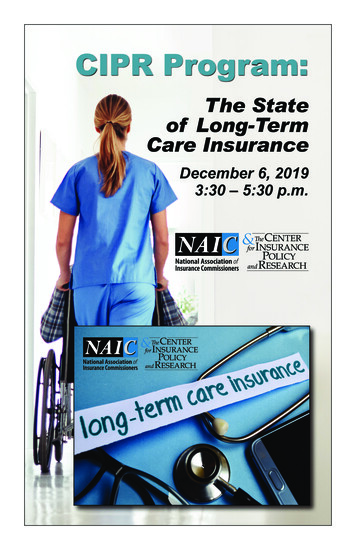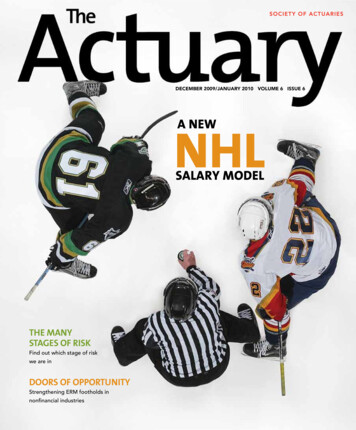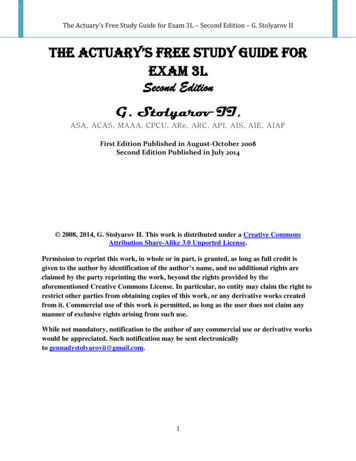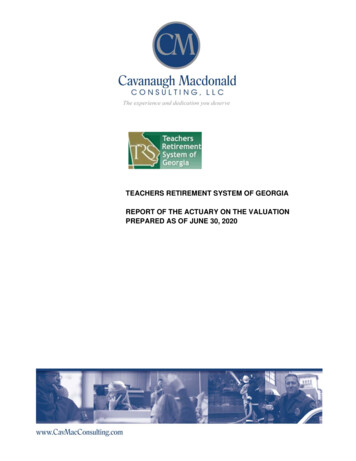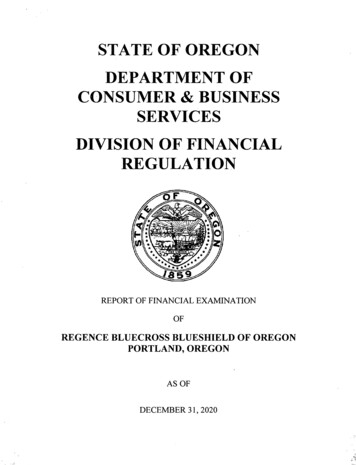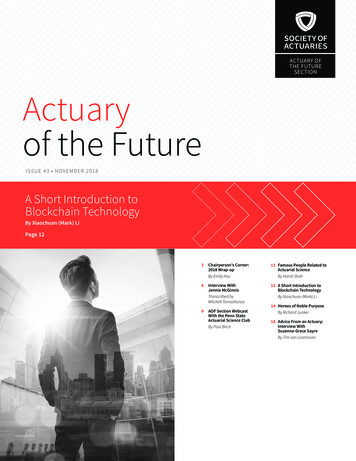
Transcription
ACTUARY OFTHE FUTURESECTIONActuaryof the FutureISSUE 43 NOVEMBER 2018A Short Introduction toBlockchain TechnologyBy Xiaochuan (Mark) LiPage 123Chairperson’s Corner:2018 Wrap-upBy Emily Hsu11 Famous People Related toActuarial ScienceBy Harsh Shah4Interview WithJennie McGinnisTranscribed byMitchell Tamashunas12 A Short Introduction toBlockchain TechnologyBy Xiaochuan (Mark) Li9AOF Section WebcastWith the Penn StateActuarial Science ClubBy Paul Birch14 Heroes of Noble PurposeBy Richard Junker18 Advice From an Actuary:Interview WithSuzanna-Grace SayreBy Tim van Laarhoven
Actuary ofthe FutureIssue 43 November 2018Published biannually by theActuary of the Future Sectionof the Society of Actuaries.475 N. Martingale Road, Suite 600Schaumburg, Ill 60173-2226Phone: 847.706.3500 Fax: 847.706.3599www.soa.orgThis newsletter is free to section members. Current issues are available on theSOA website (www.soa.org).To join the section, SOA members andnon-members can locate a membership form on the Actuary of the FutureSection webpage at landing/.This publication is provided for informational and educational purposes only.Neither the Society of Actuaries nor therespective authors’ employers make anyendorsement, representation or guarantee with regard to any content, anddisclaim any liability in connection withthe use or misuse of any informationprovided herein. This publication shouldnot be construed as professional orfinancial advice. Statements of fact andopinions expressed herein are those ofthe individual authors and are not necessarily those of the Society of Actuaries orthe respective authors’ employers.Copyright 2018 Society of Actuaries.All rights reserved.Publication SchedulePublication Month: May 2019Articles Due: Feb. 12, 20192 NOVEMBER 2018 ACTUARY OF THE FUTURE2018SECTIONLEADERSHIPOfficersEmily Hsu, ASA, CERA, ACIA, ChairpersonDerek Ray, FSA, MAAA, Vice ChairpersonLaura Wiland, FSA, MAAA, SecretaryWoolford London, ASA, MAAA, TreasurerCouncil MembersPaul Andrejko, FSA, CERA, MAAAAndrew Bourg, ASA, MAAAMinyu Cao, FSA, CERARenee Gao, ASA, CERA, ACIAMark (Xiaochuan) Li, ASATim van Laarhoven, ASA, MAAANewsletter EditorMark (Xiaochuan) Li, ASAxli@rgare.comProgram Committee CoordinatorsWoolford London, ASA, MAAA2018 Life & Annuity Symposium CoordinatorTim van Laarhoven, ASA, MAAAHarsh Shah, ASA2018 Health Meeting CoordinatorsLaura Wiland, FSA, MAAARenee Gao, ASA, CERA, ACIA2018 SOA Annual Meeting & Exhibit CoordinatorsSOA StaffBeth Bernardi, Staff Partnerbbernardi@soa.orgJane Lesch, Section Specialistjlesch@soa.orgJulia Anderson Bauer, Publications Managerjandersonbauer@soa.orgJulissa Sweeney, Senior Graphic Designerjsweeney@soa.org
Chairperson’s Corner:2018 Wrap-upBy Emily HsuThe 13th Speculative Fiction Contest, available to SOA members and candidates (who have passed one exam), is back with alarger prize pool.1 We also strengthened our relationship withCandidate Connect and the SOA University Outreach Program;now our efforts to reach university students are more focusedand leverage the SOA’s established connections.WEBCAST AND PODCASTSIn the past year, the Actuary of the Future (AOF) Section continued many of its ongoing activities and also pushed forwardseveral new initiatives that came out of the in-person councilmeeting in February.AOF HOT TOPICSIn June 2018, AOF started sending monthly emails to section members with a curated list of trending industry newshandpicked by the council. The selected topics range fromapplications of new technologies, changing landscapes such aslegislation and players, and emerging trends in internationalmarkets. This creates more communication touchpoints withour members and constantly keeps the future on their minds.SOA MEETINGSAt the Life and Annuity Symposium in May in Baltimore,AOF discussed the competency framework and invited a panelof experts to discuss how university programs are reacting tochanges to Society of Actuaries (SOA) qualification requirements. At the June Health Meeting in Austin, Texas, AOFco-hosted the Women’s Leadership Forum as well as a hotbreakfast session. At the Predictive Analytics Symposium heldin Minneapolis in September, AOF coordinated the session thatexplored more effective uses of the Delphi study. At the October SOA Annual Meeting & Exhibit in Nashville, Tenn., AOFdiscussed considerations when changing specialties and how theparadigm shift in the workplace will impact actuaries.COLLABORATION WITH OTHER SOA GROUPSWe co-hosted a networking event in New York City in Marchwith the International Section and the Entrepreneurial & Innovation Section and co-sponsored breakfast sessions at variousSOA meetings. This provides our members with more opportunities to meet and network with members from other sections.We hosted webcasts with Pennsylvania State University, University of Illinois, Iowa State University and Lebanon ValleyCollege with a panel of working actuaries with different education and career backgrounds. The events were very well receivedby students, and we are looking to reach more students strategically. We also produced several podcasts where we intervieweddifferent actuaries on their career progressions, discussed theimportance of mentorship in shaping the future of the profession, and explored nontraditional opportunities for actuaries.The latest podcast is easily accessible on the AOF webpage, andprevious ones can be found on the SOA Podcasts list.2LOOKING FORWARD TO 2019We thank you for your continued support and participation inthe AOF. As we move forward as a section, keep an eye out forwhat the council has prepared for you. Will you write for theActuary of the Future newsletter? Will you enter contests? Willyou take home AOF swag? Stay tuned for more! We are alwayslooking for volunteers, so reach out to any council member toget involved.In closing, I would like to thank the 2017–2018 section councilfor their support and efforts in making all AOF activities possible. I am confident that under the leadership of the incoming2018–2019 chairperson, Laura Wiland, AOF is headed in apromising direction. Emily Hsu, FSA, CERA, ACIA, is the outgoingchairperson of the Actuary of the Future Section.She is an assistant actuary at Sun Life Financialin Waterloo, Canada, and can be reached atEmily.Hsu@sunlife.com.ENDNOTE1 To view the complete Speculative Fiction Contest rules, visit ytics-futurism-landing/.2 See -landing/ and https://www.soa.org/pdopportunities/?filters Location[Online];Opportunity Type[RECORDING], respectively.NOVEMBER 2018 ACTUARY OF THE FUTURE 3
Interview WithJennie McGinnisTranscribed by Mitchell TamashunasJM: Sure. So, I actually took a while to find the actuarial profession. It ended up being my third major in undergrad. Throughall of those choices, what I was really in search of was a wayto practically apply math concepts. So, I was very happy onceI discovered actuarial science. But, given that I found it a bitlate during my undergrad, I ended up pursing a master’s degreefor reasons of supporting my actuarial knowledge, but alsobecause of other aspirations too. I have been with Swiss Re sinceI graduated, following internships with both a direct [insurer]and a consulting firm. Also, this year I’m celebrating the 10thanniversary of having earned my FSA and CERA designations.MT: Great, and what’s been your career progression so far?JM: Swiss Re has a rotation program and I was able to takeadvantage of that. On top of that, because of some organizational changes along the way, it meant that I didn’t necessarilystay in one rotating spot for all that long. Through the first halfof my career, I held positions in pricing, new business development, as a project manager and as the lead for the U.S. valuationmodeling team. This was all before I started focusing on in-forcemanagement.Jennie McGinnis, FSA, CERA, MAAAActuary of the Future recently had the pleasure of interviewing Jennie McGinnis, FSA, CERA, MAAA, SVP ofSwiss Re, about her perspectives on career development,industry trends and Society of the Actuaries (SOA) service.This transcription includes many great insights and advice thatis especially interesting to readers who have not yet listened tothe podcast.Mitchell Tamashunas: Welcome to the Society of Actuaries’ Actuary of the Future podcast, sponsored by theActuary of the Future [Section]. My name is MitchTamashunas, and I’m currently a student at the University of Iowa. During today’s podcast, we’re going tobe talking about reinsurance and getting involved inthe SOA. To help us do that, we’ll be talking to JennieMcGinnis, who is a senior vice president at Swiss Reinsurance. Jennie, thank you for joining us.Jennie McGinnis: Happy to be with you today.MT: To jump right in, can you tell us a little about yourbackground?4 NOVEMBER 2018 ACTUARY OF THE FUTUREI’ve been in in-force management for just over five years, whichis quite a difference from all that movement that I had initially.However, within the in-force management team, I’ve grownmy responsibilities over time. I started in a role that supportedpeople making decisions within the team [I was in]. I began tocarve out certain paths that I was responsible for, now being aportfolio manager myself. This means taking the lead in settingthe direction of the team and ensuring the performance for alarge part of our books. While some of that work is to protectperformance, the really exciting part is coming up with newsolutions that can help us and our clients improve performance,and ultimately support policyholders even better.I’ve also been able to participate in some really enjoyable sideprojects during this time. A couple of examples that were reallymeaningful for me have been to lead branding and communication efforts for regional divisions and being part of a project toupdate our global life and health strategy.MT: Great, thank you. So, you said you joined Swiss Re rightout of college. Why did you choose to work in reinsurance?JM: At the time that I was looking for a full-time position, itjust seemed to be the right mix of both the direct company andconsulting-type work. As I said, I had a chance to try out bothof those through internships. I’d say that since coming intoreinsurance, my experience has matched that, where I’ve hada bit of both. It’s not to say that you couldn’t have that same
mix at a different kind of firm, but I’ve really been able to findways to connect to the products themselves, be able to advise onsolutions and also to be able to really implement those solutionsas well.MT: Thank you. And now I will pass it on to Harsh Shah,who will talk to you a little bit more specifically about yourwork in reinsurance.Harsh Shah: Hi, Jennie. I also work in reinsurance. So,I was curious, you mentioned a little bit about how yourwork differs from a direct insurer or a consulting company.Can you expand a little bit more on how the work at a reinsurance company, for someone coming into the profession,would be different?JM: So, that’s a really interesting question, and I don’t know thatthe work or the tasks themselves vary all that much, but oneaspect that I think certainly is different is just how close you areto the ultimate consumer. So, as a reinsurer, we have a theoryabout how doing something different might incent a certainpolicyholder behavior, say to keep their policy for longer. Wecan’t just go make net change; we need to partner with a directcompany to do something like that. On the other hand, if I wereat a direct company considering a similar change, we couldmake a change like that. However, there’d be some real value inconsulting with a reinsurer to tap into their broad data set andtheir knowledge about the market in general.HS: Yes, I agree. That’s also similar to what I have beennoticing. I’ve seen that at a direct insurer, you have a littlemore focus or strategy to reach out to the consumer market, whereas, with reinsurers, it’s more business to business.This is also true since we’re working a lot more with othercompanies rather than people or regular consumers.So, changing my train of thought, over the past 10 years,what’s the biggest change you’ve seen in the actuarialindustry and how do you think actuaries have had to developthemselves to adapt to this change?JM: That’s a little bit more difficult for me because it’s reallyhard to identify one big change. I think a lot of changes actuallyhappen incrementally. Because of this, it’s hard to be able to pickup on a huge, quick shift. Rather, I would focus in on the secondpart of the question, which is to say how to really adapt to stayrelevant in an everchanging world. For me, I really focus onthree things: communication, decision-making and technology.On the communication front, I think there’s an obvious stereotype that actuaries can do the math but can’t talk about it orexplain what it all means. That leads into decision-making.Actuaries have roles not only in helping people make decisionsbased on the analysis they have done, but also have opportunitiesto be in roles where they themselves really are key decisionmakers. I think both of those concepts are made more interesting by the changing technological landscape. As our tools andsystems change, the methods we use change. Predictive analytics, for example, becomes more and more important. There’san adaptation needed to know how to use the new methodscertainly, but then—back to my previous themes—I think thatthere’s just as importantly a question about how we help ourstakeholders see through what might be considered a black box.None of these are issues that can be addressed or are adaptations that can take place overnight. However, I think there’s stillsomething to be said for continuous development to make surewe don’t find ourselves left in the dust.HS: I definitely agree with what you said about continuousdevelopment. I think that’s how you stay relevant. So, usingthat thought process and building on top of it, looking into thefuture, what are a few big changes you anticipate happeningin the industry in the next 10 years, and do you see actuarieshaving to develop a different set of skills to stay relevant?JM: So, now I have to take back my answer about things notbeing so big and incremental. But, in terms of the next 10 years,my eyes are really on technological changes. Specifically, thosethat create opportunities to enhance the whole entire insuranceprocess. So, how do you help people get life insurance coveragefaster? Are they willing to use that process if it means that theyare giving up some of their privacy? How do you more quicklyreact to people’s needs as they change? Does that freak themout that you happen to know and recognize that their needs arechanging? There are product designs and aspects that answerthe questions that I’ve just asked, and actuaries certainly play apart of that. How do you develop these products? What do theylook like? How do they move and change in that environment?I think the other consideration is, what if we don’t answer thesequestions? As a profession, what happens is another professionsteps in [that] can address these questions. For the companythat you’re working for, what if others find a way to do thesethings and you don’t, and you’re left with much less business?Or maybe you have business, but it ends up leaving you withan unbalanced portfolio of risks? So, as technology changes, thequestions we have to ask will change too, but hopefully we’ll beable to come up with answers for all of these changing questionsand environments.HS: I absolutely agree, and I know a lot of people are working on making sure that that happens at the moment. So,from your experience, is there a trend that you’ve seen thatimpacted the reinsurance industry specifically? SomethingNOVEMBER 2018 ACTUARY OF THE FUTURE 5
Interview With Jennie McGinnisthat the direct insurer might not have seen or have impactedthem as much?JM: So, what comes to mind for me is actually an ongoingquestion, and it’s a question that affects the direct insurancecompany too, just a little differently. The question is: How dowe grow our business? For a direct company, they’d be considering that question with respect to policyholders; a reinsurancecompany will be considering it with respect to the amount ofrisk that is out there that needs reinsurance coverage. This goesto my earlier comment about one way of having the need formore reinsurance coverage is to ensure that there is a largerinsurance pool. But what about contacting and working with thepolicyholders? That really needs to be done in partnership witha direct insurance company.So, if I think about how we grow our business otherwise, Iwould say that another example is if there is an active M&A[mergers and acquisitions] market among direct companiesthat will result in companies that are larger and more capableof managing larger lines of risk themselves. In which case,the reinsurer needs to ask themselves, how do we continueto provide value? I think part of that question is answeredby considering the risk profile of this new resulting directcompany, how that changed, whether it creates new opportunities. I would also say, working in in-force management,I see the questions answered often in part by considering6 NOVEMBER 2018 ACTUARY OF THE FUTUREwhat arrangements are already in place and how those can bemodified, rather than strictly thinking about how to get whatwould be properly called “new” business. Is there anotherway? How can you draw even more value out of what wealready have?HS: Agreed. Thank you very much for speaking to me aboutthe reinsurance side and also how you foresee changes inthe actuarial industry. At this point, though, I want to passit off to Paul, who will speak with you a little bit more aboutyour career.Paul Birch: Hi, Jennie. It’s so nice to get the chance to talkto you. I’m a student at Penn State. So, talking with youso far, it’s clear you have a number of great experiences andsuccesses throughout your career. However, I also wantedto talk to you about challenges you’ve faced throughoutyour career. So, what would you say has been your biggestchallenge throughout your career, and what did you have todo to overcome it?JM: Thanks, Paul. That’s a big question to think about. I’d sayfor me, the biggest challenge has really been the transition intoleadership and, through that process, trying to hold togetherwhat I’ll call “two identities.” One as an actuary and one moregenerally as a business person. When I first started working, Ileaned into some of my training in communications—because I
was a communications minor—in order to try and differentiatemyself from other actuarial students. As I started taking on rolesthat weren’t strictly actuarial, I found myself looking for waysto try to lean into and come back toward my actuarial technicaltraining, to be able to differentiate myself from others aroundthe organization. And to be fair, I don’t know if this is somethingthat I can ever really overcome, or anybody can overcome. Ithink it’s something to be aware of, to grow into and get usedto. In particular, I think it’s important to recognize when oneaspect, characteristic or strength of yours is really more valuableto a group than another.To say it a different way, sometimes it’s more important andvaluable to the team that I’m working with for me to be moretechnical. It might still be at the same company, but with anothergroup it might be much more important for me to lean intomy communications skills and those abilities. So, really, it justcomes down to knowing what situation you’re in, and which ofthese strengths or skills are most valuable at that time.PB: That sounds like a really great lesson, Jennie. Especiallylearning how to recognize your own skills to maximize yourvalue in any position. I’m glad you’ve been able to continueto overcome that and to take on some great leadershippositions. Having taken on leadership positions in yourcareer, what have you found to be the benefits of staying atone company throughout your entire career?JM: This is an interesting question, too. Especially from theperspective of it being common for people to change rolesor companies more often nowadays. For me, I would say twothings come to mind. First is having that variety of experiencewithout having to relocate or learn a new corporate culture, orother similar changes that would come with changing companies. Aside from that, I would say being able to continuouslygrow and enhance my abilities to connect the dots across theorganization that I am in. Even that has two aspects, too. Oneis just understanding what the business is, how it works, how itoperates more broadly. But the second is being able to understand the people that I’m working with, understand how peopleprefer to work and operate across the organization and globe.And, to leverage all that into building a really solid network.PB: That sounds great, Jennie. It sounds like it’s a reallynice mix of both variety and familiarity. I’m glad that’s beenworking well for you. So, outside Swiss Re, you’ve also hadsome active roles in the SOA. Can you talk a little bit abouteach of the positions you’ve held in the SOA? Specifically,how you got them and what they entailed.JM: Absolutely. This is a very important component of mycareer in its development so far that we really haven’t touchedon. I started volunteering right around the time that I got myFSA. I’ve progressively taken on new roles and challenges inthe SOA, similar to the way that I’ve taken on new roles andchallenges within Swiss Re.So, I think the first thing that I got involved in was when somebody asked me to. That was to get involved in a webcast. Thatled to being encouraged to run for, and ultimately being electedto, the Actuary of the Future Section Council. As part of thatrole, I focused on professional development opportunities. Thismeans planning meeting sessions [and] continuing to work onwebcasts, and I was also the chair of the council during my thirdyear. During that time, we also established the role of the Section Council intern, so it’s really such a pleasure to be able totalk to you guys, as the Section Council interns, and know thatthis is something we did that has really lasted.Around the same time that I was on the AOF Council, theSOA created the Professional Development Committee. I wasselected to represent the special interest sections [which includesthe AOF]. Actually, one of our first actions as the ProfessionalDevelopment Committee was to start offering podcasts. Again,this has just been such a great experience to be able to see onemore thing that has lasted. I also ultimately served as the chairof the Professional Development Committee. It was followingthat term that I was elected to the board. My board responsibilities continued on the thread of professional development, butI also began picking up responsibilities related to strategy forthe organization. Also, I had board and leadership developmentresponsibilities.I think it’s worth mentioning too that on both sides of my boardexperience, just before joining the board and the last year of myboard term, I served on two different strategic-planning taskforces. Those are really eye-opening experiences for me fromthe perspective of trying to think more broadly: to see outsideourselves, to really consider what’s going on in the market andthe environment that can have an impact on actuaries. And, notonly think about what it could mean for us, but ultimately to seta direction for how we react to, or address, these things that arechanging around us.It’s been about a year now since I’ve rolled off the board. I’vestayed involved in governance work, and that’s really focused onhow the SOA is structured, how decisions are made within thatstructure, and thinking about the structure and decision-makingprocess, and how those can be made more effective.I’ve more recently been focused on launching a subgroup withinthe Product Development Section that focuses on supportingpeople who practice in the area of in-force management. We arein the very early stages of that, but we already have a very solidNOVEMBER 2018 ACTUARY OF THE FUTURE 7
Interview With Jennie McGinnisagenda planned for this year. All in all, I have to say volunteeringwith the SOA has been a fabulous way to develop both personally and professionally.PB: That sure sounds like a great experience, Jennie. It’s soneat that it’s come full circle working with the interns forthis podcast. Thanks so much for giving us the opportunities to do these things. Looking at some aspiring actuariesor young actuaries who are listening to this, what wouldyou say are the best ways to become involved in the SOA,and what are some of the rewards that come with becominginvolved in professional [section] councils?JM: That’s a very good, practical question. So, in terms of howto become involved, there’s really two ways. You can reach outor you can have someone tap into you. I was lucky that I alreadyhad a network where someone tapped me and invited me to participate. But, I would have to encourage young actuaries who aretrying to grow their network to reach out. Now, if you’re stilltaking exams, there are certain volunteer roles within the SOAthat won’t be open to you quite yet. That’s not to say that therearen’t roles available; some are. The SOA has a volunteer database that has a way of identifying roles that are already availablethat you might fit, but also a way of “raising your hand” andsaying that you’d be interested. To have the SOA essentially helpyou look for ways to fit in is fantastic.So, in terms of the rewards of becoming engaged, I wouldsay largely it goes to developing a network. I had the chanceto speak about the value of developing a network within myfirm, but I can’t say how much more powerful it is to have thatnetwork across the industry. Also, I want to come back to mycomment about volunteering helping me develop both personally and professionally. As I think about the different roles thatI’ve had volunteering at the SOA, there’s several I can draw aline between showing that I am capable of doing certain things.As I showed that I was capable of doing things within the SOAvolunteering structure, I then used that to show my employer,“See, I can do this, so now what’s the next challenge within the8 NOVEMBER 2018 ACTUARY OF THE FUTUREworkplace to do?” I think that even goes back and forth a little,so if you develop at your employer, then you have the chance tothen bring that back to the SOA too. You can see your leadership roles grow there too.PB: That’s great to hear, Jennie. Thanks so much for helping inform us of how we can all continue to be involvedin such rewarding enterprises. That wraps it up for today’spodcast. This is Paul Birch thanking you for tuning in. Wehope that you have gotten a lot out of our discussion today.I also want to thank Jennie McGinnis for joining us. Jennie,it was great talking to you today.JM: It was a pleasure to spend time with all of you.PB: We hope you can join us again soon for another SOAActuary of the Future podcast. Mitchell Tamashunas is currently a senior atthe University of Iowa, majoring in statisticsand earning a Risk Management and Insurancecertificate. He can be reached at mitchbtam@gmail.com.
AOF Section WebcastWith the Penn StateActuarial Science ClubBy Paul BirchIn an ongoing effort to engage not only newly professionalactuaries but also aspiring students, the Actuary of the Future(AOF) Section has been organizing webcasts with actuarialprograms at different universities. Reaching out to studentsbefore they even enter the workforce is a fantastic way to bothspread awareness of the functions of the AOF Section and toencourage future professionals to join and become involved indifferent SOA sections once they enter the workforce.In April, three AOF Section Council members gathered infront of the cameras to give advice to and answer questionsfrom inquiring students in the Penn State Actuarial ScienceClub. The panelists were Paul Andrejko, FSA, CERA, MAAA, adirector and actuary at New York Life; Renee Gao, ASA, CERA,an actuary at Berkshire Hathaway; and Harsh Shah, ASA, anactuarial associate at Munich Re. The actuaries and studentshad an hour-long dialogue that covered many interesting andsomewhat under-discussed aspects of the actuarial profession.As a Center of Actuarial Excellence (CAE), Penn State hosts avariety of information sessions and recruiting events from different companies. This event was advertised as unique from theordinary information session, as the panelists would be neitherpromoting their companies nor seeking internship or full-timeapplicants; rather, they would be serving as independent, unbiased, experienced actuaries. Thus, students could ask questionsthat would either be out of place at a company-sponsoredinformation session or that they would feel hesitant asking arecruiter. Students came armed with this knowledge and poseda variety of hard-hitting and insightful questions about the actuarial profession.One of the questions that particularly piqued the students’ curiosity concerned whether the panelists ever feel bored at work.This is a fair consideration when entering any career, and, onthe face of it, people who work primarily with math and insurance could be assumed to have some generally uninterestingworkdays. The panelists responded with a number of helpfultips, acknowledging that though people are likely to face someuneventful workdays in nearly any industry, there are a numberof strategies to avoid boredom. First, all actuaries should generally have some interest in the industry and work they are doing;if not, they should reconsider their career calling. Second, ifthere is simply a slow afternoon or hour, listening to music canhelp
With the Penn State Actuarial Science Club By Paul Birch 11 Famous People Related to Actuarial Science By Harsh Shah 12 A Short Introduction to Blockchain Technology By Xiaochuan (Mark) Li 14 Heroes of Noble Purpose By Richard Junker 18 Advice From an Actuary: Interview With Suzanna-Grace Sayre By Tim van Laarhoven A Short Introduction to


